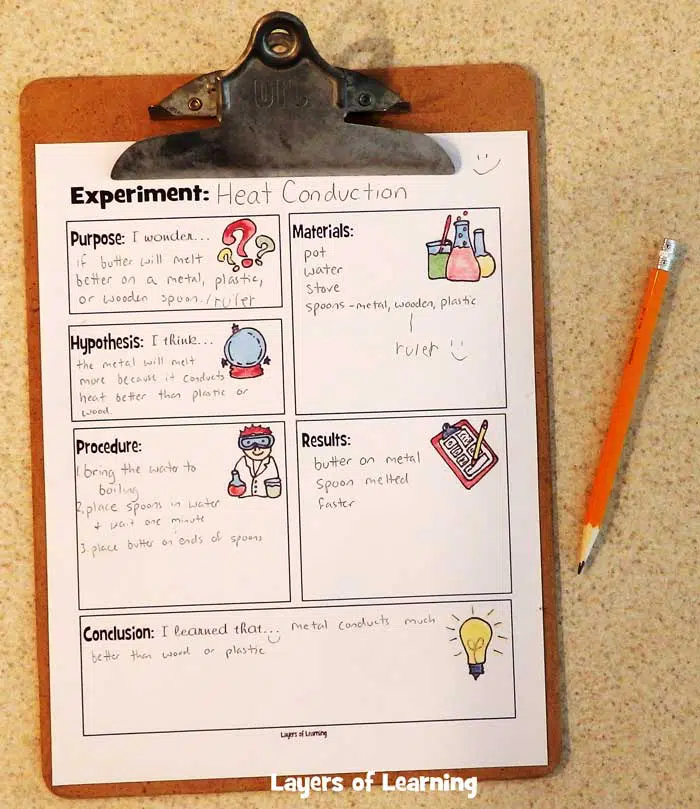This exploration is for all ages, as the colored smilies show. You can do the heat conduction experiment with your whole family together!




The heat conduction experiment is a physics lesson from the Thermodynamics unit. Layers of Learning has hands-on experiments in every unit of this family-friendly curriculum. Learn more about Layers of Learning.
Heat is conducted through a material, like a spoon, by vibrating and colliding molecules in the spoon. The higher the heat, the higher the vibrations. Heat can also be conducted from one material to another, like water to a spoon, through the water molecules vibrating against the spoon’s molecules.
Some materials conduct heat better then others. In this experiment you’ll get to see how plastic, metal, and wood compare in their ability to conduct heat.
Step 1: Library Research
Before you begin exploring, read a book or watch a video about heat conduction. Here are some suggestions, but if you can’t find these, look for books at your library about heat conduction. The colored smilies above each book tell you what age level they’re recommended for.
As Amazon affiliates, the recommended books and products below kick back a tiny percentage of your purchase to us. It doesn’t affect your cost and it helps us run our website. We thank you!

The Energy That Warms Us
by Jennifer Boothroyd


Heat Transfer
by Crash Course

Thermal Conduction, Convection, and Radiation
by Khan Academy
Step 2: Heat Conduction Experiment
WARNING! This experiment uses very hot water and a hot burner. Young children should be kept back while an older child (already trained in the use and safety of hot stoves) or adult performs the experiment.
For this experiment you will need a stove or hot plate, a pot of water, three spoons made of different materials: metal, plastic, and wood, and butter or margarine.
Start by putting a pot of water on the hot stove. Once the water is good and hot (boiling or near boiling), carefully place 3 different spoons in the pot – one metal, one plastic or rubber, and one wooden spoon. Wait a few minutes for the spoons to heat up.

The next step is to make a prediction or hypothesis about what will happen if you place a little pat of butter on each of the spoons. Have the kids write down their hypotheses. Here is a scientific method experiment sheet to use for this experiment.
The actual experiment happens very quickly, so make sure everyone is ready and watching when you put a pat of butter on each one.
The butter on the metal spoon almost immediately melted away; the butter on the wooden spoon melted some; meanwhile, the butter on the plastic spoon stayed firm much longer. The heat was transferred by moving molecules within the spoons.
Metal conducts heat much better than plastic or wood.
Complete your experiment sheets with a labeled drawing of the experiment, a description of the method used, and the results.

Step 3: Show What You Know
Now that you know metal is a better conductor of heat than plastic or wood, design an experiment to test other materials against metal like glass and ceramics or fabrics. But this time don’t use a pot of boiling water. Write up your hypothesis, materials, method, and results.
Additional Layers
Additional Layers are extra activities you can do or tangents you can take off on. You will find them in the sidebars of each Layers of Learning unit. They are optional, so just choose what interests you.
On the Web
Check out this interactive website to learn about the three ways heat is transferred – conduction, convection, and radiation – and what the difference between them is.
Additional Layer
Some kids may ask if cold is conducted too. The answer is no. Scientifically, cold is the absence of heat, so only heat is conducted. If something feels cold that is because it is conducting your heat away from your body.
Deep Thoughts
Is the blanket on your bed a good heat conductor? That doesn’t mean “Does it keep you warm?” It means, “Does heat transfer through your blanket quickly and easily?”
Sometimes things are useful to us because they conduct heat well, and some things are more useful to us because they don’t. What would happen if the hot pads you use to get cookies out the oven were good heat conductors?
Get a Free Unit
Choose between the first unit in each Layers of Learning subject to try for free when you sign up for the newsletter.
We never spam and you can cancel your subscription at any time.









This is soooo cool!!!!
Can this be done with chocolate?
Anything melt-able will work. Butter is just easily melt-able so it’s easy to see. Chocolate might take a little longer to melt on your metal spoon, but yeah, it should work.
can this be done with a knife?
It can be done with any utensils that will hold the butter and are made of the three basic materials – a heat-tolerant plastic, wood, and metal.